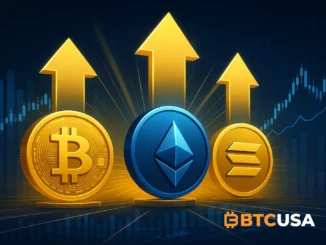Experts Predict Bitcoin Surge, Stablecoin Risk Amid U.S. Debt Default Fears
As the United States faces mounting concerns over its debt ceiling, analysts are weighing how a potential default could impact Bitcoin (BTC), stablecoins, and the broader crypto market.
Experts suggest that while Bitcoin could benefit as a safe haven asset, stablecoins tied to the U.S. dollar might experience significant stress if a default occurs.
The Debt Ceiling Crisis
The U.S. officially hit its borrowing limit in January 2023. Treasury Secretary Janet Yellen warned that the country could default as early as June 1 unless Congress raises the debt ceiling.
While President Joe Biden and major financial institutions like JPMorgan have downplayed the likelihood of a default, uncertainty continues to ripple across global markets.
U.S. debt has ballooned over the past decade, driven by stimulus spending during the 2008 financial crisis, COVID-19 relief efforts, and rising geopolitical tensions.
Bitcoin as a Safe Haven
Bloomberg analysts believe a U.S. default could trigger capital inflows into gold, U.S. Treasury bonds, and Bitcoin. Bitcoin’s decentralized nature and finite supply make it attractive to investors seeking alternatives to traditional financial assets.
Dmitry Noskov of StormGain compared Bitcoin to gold, calling it a “digital analog” that could see strong upward momentum. He predicts Bitcoin could accelerate past $30,000 if default fears persist.
Nikolai Zhuravlev, CEO of TsFA.RF, echoed this sentiment, calling Bitcoin a “safe haven” asset that could outperform even traditional strong currencies such as the yen and Swiss franc.
“Bitcoin is called digital gold,” he said, “and it’s becoming more popular than fiat currencies.”
Market Volatility and Correction Risk
However, experts also warn that Bitcoin’s high volatility could create sharp corrections following any surge.
Blockchain developer Evgeny Grechenok noted that “a sharp demand for Bitcoin will create prerequisites for growth, but a correction is likely to follow as traders lock in profits.”
Sergey Gataullin, Dean at MTUCI’s Faculty of Digital Economy, said gold, Bitcoin, and U.S. Treasuries could all see strong demand during a potential default, but the timing of entry and exit would be critical for investors.
Stablecoins Under Pressure
While Bitcoin might benefit, the stablecoin market could face significant challenges.
Arthur Meinhard, Head of Global Market Analysis at IC Fontvielle, said stablecoins could lose investor appeal because most are backed by short-term U.S. government bonds and cash.
“Stablecoins, being a derivative of the U.S. dollar, will experience significant selling pressure,” he explained. “Investors will likely shift to Bitcoin and other crypto assets, causing volatility and temporary depegging from the dollar.”
The Bigger Picture
A U.S. default could accelerate capital flow into Bitcoin and digital assets, much like the surge seen during the 2023 U.S. banking crisis. However, experts caution that the crypto market remains closely tied to traditional finance — meaning broader market instability could also create headwinds for digital assets.
While Bitcoin might benefit as “digital gold,” stablecoins and riskier tokens could experience heightened volatility, testing the resilience of the entire crypto ecosystem.
As the debt ceiling debate continues, the crypto industry stands at a crossroads — potentially poised to benefit from financial uncertainty while bracing for the ripple effects of a global economic shock.


